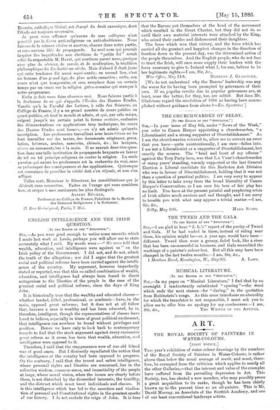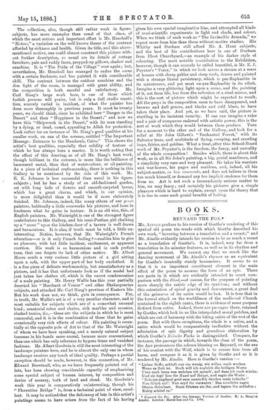ART.
THE ROYAL SOCIETY OF PAINTERS IN WATER-COLOURS.
[FIRST NOTICE.]
Tins year's exhibition of water-colour drawings by the members of the Royal Society of Painters in Water-Colours, is rather above than below the usual average of merit, and must, there- fore, be exempted from the criticism which applies to nearly all the other Galleries,—that the interest and value of the examples have suffered from the prevailing depression in Art. This Society, too, has elected a new member, who may possibly prove a great acquisition to its ranks, though he has been chiefly known up to the present time as an oil-painter. 'This iiMr. David'
avid Murray, an Associate of the Scottish Academy, and one of our least conventional landscape artists. The collection, also, though still rather weak in figure- subjects, has more examples than usual of that class, of which the most serious and important effort is Mr. Henshall's " Sisters," a variation on the well-known theme of the contrast afforded by sickness and health. Given its title, and this above- mentioned motive, one could almost construct this picture with- out further description, so usual are its details of cottage furniture, pale and ruddy faces, propped-up pillows, shadow and sunshine. It is " The Pride of the Village " over again ; but, nevertheless, Mr. Henshall has managed to endue the scene with a certain freshness, and has painted it with considerable skill. The contrast between the outdoor sunshine and the dim light of the room, is managed with great ability, and
the composition is both careful and satisfactory. Mr. Carl Haag's large work here, is one of those which foolish persons will praise, but is only a dull studio repeti- tion, scarcely varied in incident, of what the painter has done more thoroughly in previous years. It must be twenty years, we should think, since he exhibited here " Danger in the Desert" and then "Happiness in the Desert ;" and now we have this "Shipwreck in the Desert," with its man standing by a dying, or dead, camel, appealing to Allah for protection. Look rather for an instance of Mr. Haag's good qualities at his smaller work, on one of the screens, entitled " The Important Message : Entrance to the Mandarah, Cairo." This shows the artist's best qualities, especially that solidity of texture of which he has always been a master. It is worth noting that the effect of this drawing, as of all Mr. Haag's best work, though brilliant in the extreme, is more like the brilliance of hammered metal, than that of water-colour, or oil-painting. As a piece of technical craftsmanship, there is nothing in this Gallery to be mentioned by the side of this work. Mr. E. K. Johnson is less successful than usual in his figure- subjects ; but he has a study of an old-fashioned garden, set with long beds of flowers and smooth-carpeted lawns, which has a great charm, and which, in our opinion, is more delightful than it would be if more elaborately finished. Mr. Johnson, indeed, like many others of our genre painters, habitually a little overworks his pictures, and loses in freshness what he gains in texture. It is an old vice, this, of English painters. Mr. Wainright is one of the strongest figure contributors to this Gallery, and his semi-Puritan girl chalking up a " score " upon the kitchen-door of a tavern is well drawn and harmonious. It is also, if truth must be told, a little un- interesting. Notice, however, that Mr. Wainright's French education—or is it only French feeling P—enables him to give us pleasure, with but little incident, excitement, or apparent exertion. His work is so harmonious and in such perfect tone, that one forgets its lack of other motive. Mr. Albert Moore sends a very curious little picture of a girl sitting upon a sofa, with the upper part of her body unclothed. It is a fine piece of delicate workmanship, but unsatisfactory as a picture, and it has that unfortunate look as if the model had just taken her clothes off, which is the surest condemnation of a nude painting. Mr. Henry Wallis has this year partially deserted his "Merchant of Venice" and other Shakespearian subjects, and attacked Mr. Carl Haag's province of Eastern life. But his work does not, we think, gain in consequence. For, in truth, Mr. Wallis's art is of a very peculiar character, and is most suitable for subjects which are of a somewhat unusual hind ; senatorial robes and chains, rich marbles and mosaics, slashed tunics, &c.,—these are the subjects in which he is most successful, and it is in the combination of these that he gains occasionally very rich effects of colour. His painting is essen- tially at the opposite pole of Art to that of the Mr. Wainright of whom we have been speaking, and a merely natural subject becomes in his hands more unreal, because more conventional, than one which has only reference to bygone times and vanished fashions, Mr. Albert Goodwin is still the most interesting of the landscape painters here, and he is almost the only one in whom landscape receives any touch of ideal quality. Perhaps a partial exception should be made, however, in this connection, of Mr. Edward Brewtnall, who, as we have frequently pointed out of late, has been showing considerable capacity of emphasising some special subject of human interest, by composition and device of scenery, both of land and cloud. Mr. Goodwin's work this year is comparatively uninteresting, though his 4‘ Florentine Bridge " is, from a technical point of view, excel- lent. It may be noticed that the deficiency of late in this artist's paintings seems to have arisen from the fact of his having given his own special imaginative bias, and attempted all kinds of semi-scientific experiments in light and shade, and colour. When we think of such work as " The Invincible Armada," we expect more from him than these without-motive studies. His Whitby and Durham still afford Mr. A. Hunt subjects, and the best of his contributions here is one of Durham from Elvet Churchyard,—an example of his darker style of colouring. The most notable contribution to the Exhibition, however, though it can scarcely be called beautiful, is Mr. E. J. Poynter's " Ferry," in which we look across a stream at a mass of houses with sharp gables and steep roofs, drawn and painted with a strange literal persistency, which is pre-Raphaelite in its minuteness, and yet most un-pre-Raphaelite in its effect. Imagine a very glittering light upon a scene, and the painting of it, not from life, but from the reflection of a steel mirror, and this is the sort of picture which might be expected to result. All the greys in the composition seem to have disappeared, and browns and dull greens, and blacks and cold blues, to have taken their place. And yet, as we have said, the picture is startling in its insistent veracity. If oue can imagine a ruler and a pair of compasses endowed with artistic power, this is the sort of work which they would between them produce. Turn for a moment to the other end of the Gallery, and look for a relief at Sir John Gilbert's " Enchanted Forest," with its Salvator trees, and multitude of flying, creeping, and crawling imps, fairies, and goblins. What a treat, after this School-Board work of Mr. Poynter's, is the freedom, the fancy, and unreality of the whole composition ! Besides which, there is about this work, as in all Sir John's painting, a big, genial manliness, and a simplicity very rare and very pleasant. He takes his warriors and war-horses, his pages and maidens, and, indeed, all his subject-matter, en bon caznarade, and does not believe in them too much himself, or demand any too implicit credence for them from us. Art is not such a tremendously serious matter to him, we may fancy ; and certainly his pictures give a simple pleasure which is hard to explain, except upon the theory that it is due to some such genial breadth of feeling.



































 Previous page
Previous page